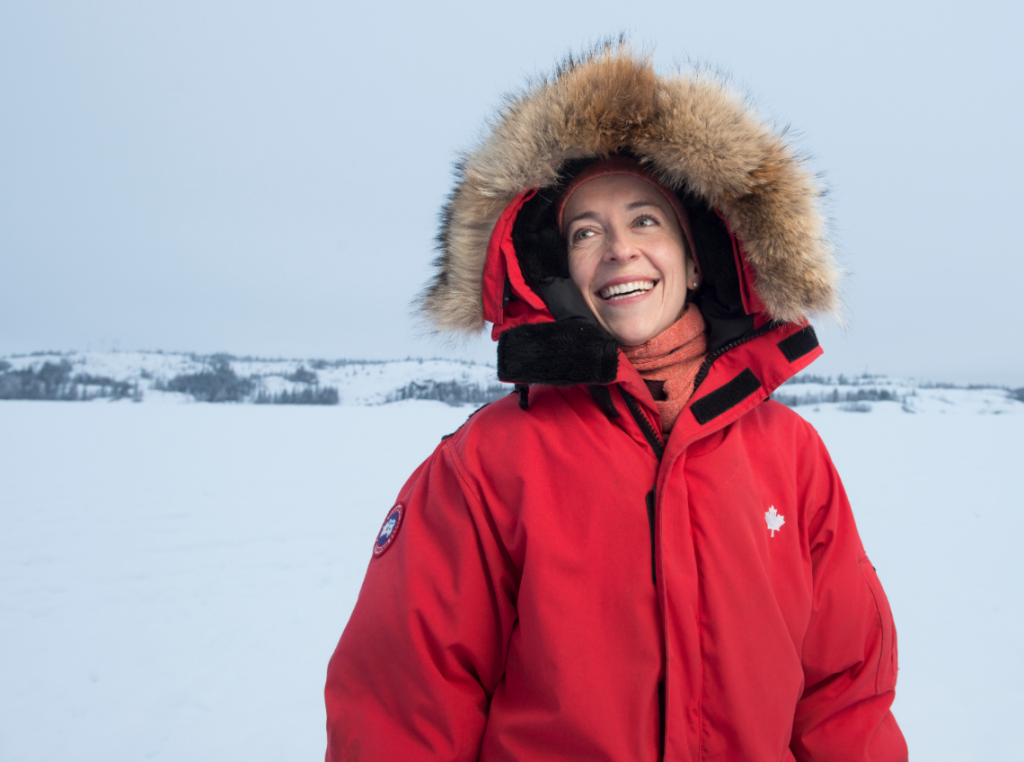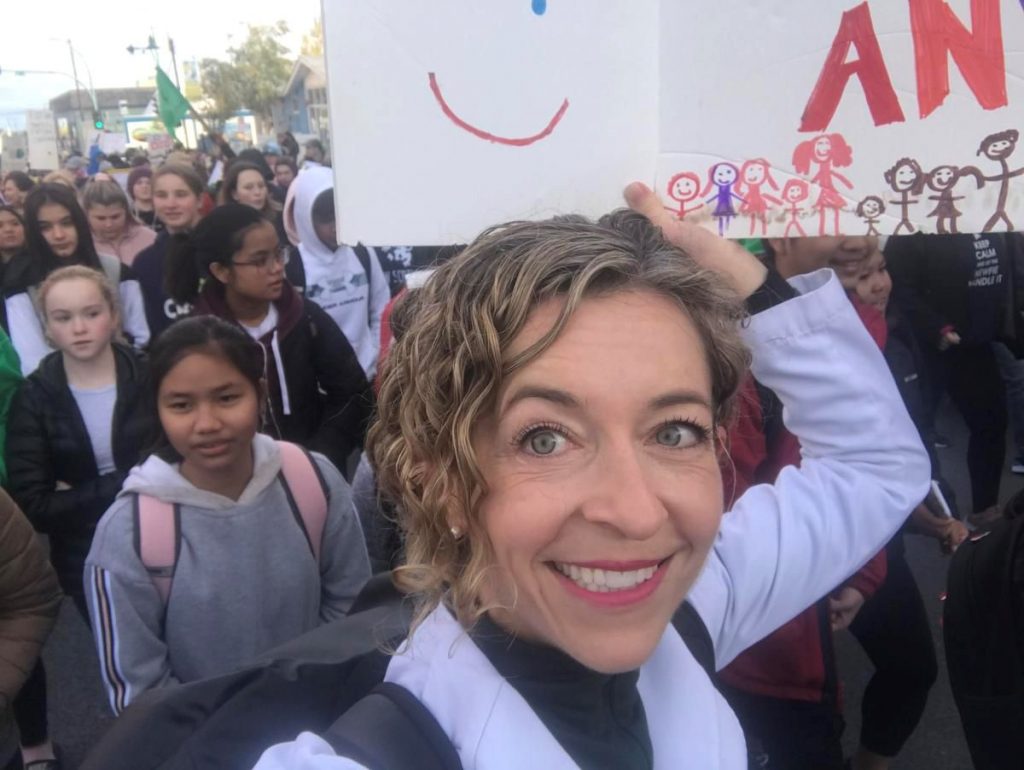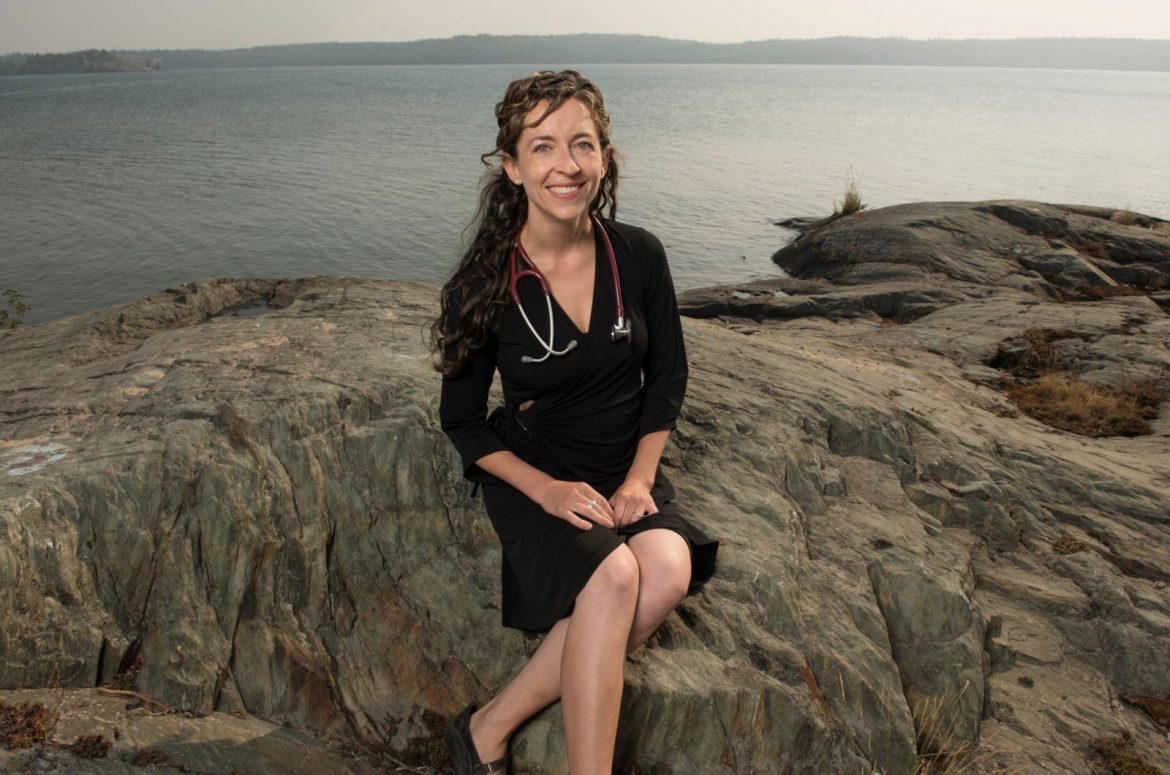Picture: National Observer
This month we are featuring in our eco-maven section an inspiring and fearless ER doctor from Canada, Dr. Courtney Howard, who is not only at the frontline attending patients during the COVID-19 pandemic and took the time to answer our questions, but she has also found time in her life to advocate for planetary health, and even lead the Lancet Countdown report – in the Canadian Policy brief- with recommendations for a healthy response to climate change. Dr. Howard gets our recognition and appreciation for all her work and for sharing with Eco18 some of her adventures with her children, in particular her teaching about bravery being a “muscle that needs exercise to grow strong.”
1. What’s your name, and what’s your occupation?
Dr. Courtney Howard. I’m an Emergency Doctor in Canada’s subarctic, and I do research, policy work, teaching, and advocacy at the intersection of climate change and human health.
2. Where are you from?
My parents met in Yellowknife, and I grew up in North Vancouver, BC.
3. Being an emergency physician in Yellowknife, in Canada’s subarctic, how did you get involved in environmental advocacy?
When I finished my ER training I started a file on my computer called “Geeky Learning About the World,” because I’d spent so much time in the previous couple of decades in study carrels and hospital call rooms focused on learning about human health that I felt like I needed to work on adulting a bit. I ended up picking up a book about climate change in the Edmonton airport on my way up to a locum in Inuvik, and had a bit of an “oh crap” moment. When I started talking to people, it turned out that I was in one of the most rapidly warming places in the world. There was no going back from there!

4. What motivates your pursuit of planetary health?
Planetary health, defined by the Lancet as, “the health of human civilization and the state of the natural systems upon which it depends,” helps us understand what we need to pay attention to if we want to be healthy. It turns out that only about 20-25% of overall health outcome is determined by what happens inside healthcare structures. The rest is underpinned by the ecological determinants of health, things like soil, water, climate, and biodiversity; the structural determinants, which include social and political systems; and social determinants, things like income and housing. If we use this frame when we think about health, we have a much better chance at making societal and personal choices that really do enhance wellbeing.
5. I understand that you have been at the frontline attending patients during the current emergency caused by COVID-19. Tell us what have you learned from this pandemic that can help in the containment and the recovery of patients here in the U.S.? What works? What doesn’t?
Up here where I live we closed the borders early, had good cooperation with social distancing, have had adequate PPE as healthcare providers, and have a brand new hospital with good infection containment capabilities. We’ve had five cases, no deaths, and no community transmission. Yesterday we began an “opening wisely” set quarantine-easing measures because it’s been 28 days since our last case. Locally, we have a fantastic chief public health officer, a territorial epidemiologist who used to work for Doctors Without Borders and who therefore treats infectious disease very seriously, and a female premier who has worked incredibly well with them to ensure we have had a science-based response that keeps everyone safe. Despite being a rural and remote area, we led the country for weeks in terms of the number of tests we performed per capita. I’m really proud of our team and our response.
6. What has Canada done differently than the U.S. to fight COVID-19?
Some of our success comes from pre-existing systems, like universal health coverage, which means that everyone can get tested for free, and from our national public health system that was set up after SARS. Overall, our political leaders have done quite a good job of aligning their recommendations with what our public health physicians have suggested. I think that looking at the different responses across nation states, it’s never been clearer that politics is a key determinant of health.
7. Last week was Nurses Week, what can you recommend to the many health personnel around the world to cope with the pain and loss of so many lives during this pandemic?
My heart goes out to all of the providers who are experiencing moral distress, trauma, and burnout as this pandemic goes along. One of the reasons I do work on climate change is that malnutrition is the #1 health risk of climate change this century, and I spent six months resuscitating severely malnourished infants and children in a slum ICU in East Africa with Doctors Without Borders. In those circumstances, you don’t have ventilators, so despite the fact that we had an excellent project of its kind, I had many children die under my care. It changed my life. I have dealt with that trauma by doing everything I can to prevent further similar deaths. I realized though, as I burst into tears at a few different points in our pandemic response when I was considering the potential for a lack of ventilators, that that experience is still part of me on a very deep level. Many healthcare providers have now experienced that kind of trauma. I was a peer-support worker for returning humanitarians with Doctors Without Borders for many years, so I know that things like sleeplessness, anxiety, compassion fatigue, substance abuse, interpersonal issues, and other challenges are common. We need to pro-actively reach out to providers and give them the support that they need, including ensuring that those who have trouble functioning are taken care of financially, and then do everything we can to avoid tragedy like this in the future.
8. As a “climate-health solution-seeker”, is there something to learn from this pandemic from the environmental perspective?
Given that this pandemic has been caused by a zoonotic infection that made its leap from animals into humans, and that we can expect more of that with worsening climate change and its impacts on habitat, we need to shift our view of health from being “healthcare” to looking at it in a planetary health frame, and addressing all of the different determinants of health.
9. What can you tell us about the effects of greenhouse gas emissions in physical and mental health? Can you highlight key aspects of the Lancet Countdown report –lead by you in the Canadian Policy brief- with recommendations for a healthy response to climate change?
According to the World Health Organization, seven million people die every year from air pollution. Many of the things that we can do to decrease greenhouse gas emissions, like transitioning from coal power to clean power, and from fossil-fuel-powered cars to zero-emissions vehicles, also save lives from air pollution. Getting to where we want to go actively, on foot, by bike, or using public transport, also decreases greenhouse gas emissions while reducing chronic disease. Eating a plant-rich diet similarly reduces our impact on the planet while improving our health. Mental health impacts of climate change can be acute, as we see with people with PTSD after evacuating past wildfire flames, or chronic as people contemplate ongoing changes. Eco-anxiety is real–we need to normalize those feelings, provide a forum for us to discuss it, and help each other heal by channeling anxiety into action.

10. What actions can parents take to guide their kids during these times of pandemics and climate threats?
Kids really pick up on parental emotion so the first step for us parents is to take our own pulse and do our best to take care of ourselves so we can be centered and take care of them. That means as best as possible getting enough sleep, avoiding too much caffeine and alcohol, and getting professional help if we sense that we need further help for us to be our best from a mental health perspective. There are a lot of financial and situational stressors right now–I’m seeing a tremendous amount of anxiety and interpersonal trauma in the ER–so please, do reach out. Everyone in the family will benefit from exercise and time outside, as well as virtual contact or socially distant visits with the people we love. It can be easy to get absorbed into the latest stats on social media but our kids want to see our faces and feel our touch. My 6 year old Vivi asked for a phone jail so many times we’ve hired a local woodworker to make one for us! So put the screen away and cuddle with your kids. Bedtime stories do everybody good.
11. If you could make only one big environmental change next year, what would it be?
Vote for politicians who will implement policies that favor a healthy environment. Trying to make personal changes of adequate scale when money and power are pushing in the other direction is like swimming upstream. We need to change the flow.
12. Changing the subject a little, and since we find it fascinating that you have a degree in contemporary dance, we read that you were working on a video that explores the concepts of ecological grief and eco-anxiety through the sequential filming of dancers in Yellowknife’s melting Snow Castle. Can you tell us more about it? When can we see it?
That’s a great question! I was planning on finishing it this spring and then a little thing called a pandemic kind of got in the way. We got some beautiful footage and are working with a gorgeous song by Indigenous musician Jay Gilday–I can’t wait to get to it.
13. If you could have a conversation with anyone living or deceased, who would it be?
Margaret Atwood.
14. How do you see the future of health worldwide after COVID-19?
There’s a huge international movement of healthcare providers calling for a healthy recovery that prioritizes planetary health. I think we’re going to see a transformation in our approach.
15. Who inspires you?
Dr. James Orbinski, Dr. Nick Watts–two heroes of the planetary health world that I’ve been lucky enough to work closely with. My two grandmothers, who were tough, funny women who lived to be 99 and 100 respectively. My mom. My two daughters–it is their eyes that I most need to meet in ten years–and they bring so much adventure and joy to my life. All of the youth who are giving their all to a healthy response to climate change.
16. What’s your secret to balance your life between work, advocacy and family?
Um. See my previous response about my six-year-old and her quest for a phone jail 🙂 I don’t always hit a balance. Fundamentally though, I think I’m more of a work-life integration kind of human. I love this work–it’s my passion. I think it has helped that I live in a small community. My commute to the hospital is exactly 11 minutes by car, and about 20 minutes by bike, and when I’m in town, if I’m not at the hospital, I work at home, so I’m there when the kids go to school and when they come home. We do have a village–it’s a great place to raise kids. ER is also a “go-hard, and then go-home” medical specialty–so I usually work six shifts in a row (2 days, 2 evenings, 2 nights) and then have multiple days off when I can catch up with the rest of my work. For the last many years I haven’t traveled for work unless I have been convinced I could have an impact–ie: I travel to present, to learn hands-on skills, and if I need to influence critical decisions. I welcome less travel in the years to come. Children are much more welcome in professional situations in this majority-Indigenous community, so if there’s a way of integrating my kids, I do. This makes a lot of sense to me–I find that having children in a room brings out peoples’ humanity, and the kids start to learn what the world is about by osmosis. They’re inheriting a challenging world–I want them to see the people who are working to make it better, because that way they’ll feel more taken care of–and have a chance to learn from them even as they contribute by bringing play and humor to sober spaces. Basically, I try to be 110% present in whatever I’m doing in a given moment.

17. Do you have any advice to give to young women looking to follow in your footsteps that you wish you had been told when you were just getting started?
All you need to do now is take the next right step–do the thing that gets you excited. If your eyes light up when you talk about it that’s a good sign. It will probably take a little bit of courage and it might be a whole lot of work. If the thought of taking it on keeps you up a bit at night–do it anyway. I’ve been telling my girls that bravery is a muscle that needs exercise to grow strong. This new step will expose you to new people, new ideas, and a new view. Once there, look around, ask questions, learn what you can, stay open to the next opportunity that starts you brainstorming and daydreaming–ask “why NOT me?” instead of “why me?”– and take a new step.
18. You are inspiring many people around the world. Can you give us a sneak peek into what you will be doing in the future?
Let’s just say that I’ve had a lot of cause lately to slightly kick myself for the number of times I’ve given people the advice to do the thing that scares them. But I’ve decided to keep walking my talk. Stay tuned!
 Food
Food Farmers
Farmers Sustainable Living
Sustainable Living Living Planet
Living Planet News
News